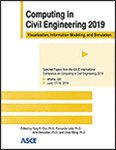ASCE International Conference on Computing in Civil Engineering 2019
Scan2BrIM: IFC Model Generation of Concrete Bridges from Point Clouds
Publication: Computing in Civil Engineering 2019: Visualization, Information Modeling, and Simulation
ABSTRACT
Generating a semantically enriched solid model of a structure from point cloud data is time-consuming. Many reinforced concrete bridges consist of a specific set of structures for which a large part of the processing from scan to bridge information model (BrIM) can be automated with today’s algorithms. We contribute a pipeline for going from a laser scan point cloud to a BrIM for simple concrete bridges (girder, box girder, and slab). The procedure consists of four major steps: (1) top-down partitioning of the bridges, (2) bottom-up segmentation of the component surface elements, (3) recognition of components from surface elements, and (4) reconstruction of the components. The top-down partitioning step informs machine learning methods for identifying the bridge component type and its geometric model. Application of the pipeline to two bridges demonstrates that conversion to BrIM at level of detail 200 is possible. The pipeline takes less than 1 hour of user time, which is less than scanning time, thus inverting the Scan2BrIM labor ratio.
Get full access to this article
View all available purchase options and get full access to this chapter.
REFERENCES
Ahmed, M. F., Haas, C. T., & Haas, R. (2014). Automatic Detection of Cylindrical Objects in Built Facilities. Journal of Computing in Civil Engineering, 28(3), 04014009.
Anagnostopoulos, I., Belsky, M., & Brilakis, I. (2016). Object Boundaries and Room Detection in As-Is BIM Models from Point Cloud Data. Paper presented at the Int. Conference on Computing in Civil and Building Engineering.
Anagnostopoulos, I., Pătrăucean, V., Brilakis, I., & Vela, P. (2016). Detection of Walls, Floors, and Ceilings in Point Cloud Data. In Construction Research Congress 2016.
Bosché, F., Ahmed, M., Turkan, Y., Haas, C. T., & Haas, R. (2015). The value of integrating Scan-to-BIM and Scan-vs-BIM techniques for construction monitoring using laser scanning and BIM: The case of cylindrical MEP components. Automation in Construction, 49, 201-213.
Chen, J., Fang, Y. H., & Cho, Y. K. (2017). Unsupervised Recognition of Volumetric Structural Components from Building Point Clouds. In Int. Workshop on Computing in Civil Engineering(pp. 34-42).
Lu, R., & Brilakis, I. (2017). Recursive Segmentation for As-Is Bridge Information Modelling. Paper presented at the Joint Conference on Computing in Construction, Heraklion, Greece.
Lu, R., Brilakis, I., & Middleton, C. R. (2018). Detection of Structural Components in Point Clouds of Existing RC Bridges. Computer-Aided Civil and Infrastructure Engineering.
Pătrăucean, V., Armeni, I., Nahangi, M., Yeung, J., Brilakis, I., & Haas, C. (2015). State of research in automatic as-built modelling. Advanced Engineering Informatics, 29(2), 162-171.
Riveiro, B., DeJong, M. J., & Conde, B. (2016). Automated processing of large point clouds for structural health monitoring of masonry arch bridges. Automation in Construction, 72, 258-268.
Son, H., Bosché, F., & Kim, C. (2015). As-built data acquisition and its use in production monitoring and automated layout of civil infrastructure: A survey. Advanced Engineering Informatics, 29(2), 172-183.
Thomson, C. (2016). From Point Cloud to Building Information Model: Capturing and Processing Survey Data Towards Automation for High Quality 3D Models to Aid a BIM Process. University College London,
Thomson, C., & Boehm, J. (2015). Automatic Geometry Generation from Point Clouds for BIM. Remote Sensing, 7(9), 11753-11775.
Wang, C., Cho, Y. K., & Kim, C. (2015). Automatic BIM component extraction from point clouds of existing buildings for sustainability applications. Automation in Construction, 56, 1-13.
Yan, Y., Guldur, B., & Hajjar, J. F. (2017). Automated Structural Modelling of Bridges from Laser Scanning. In Structures Congress(pp. 457-468).
Zhang, G., Vela, P. A., & Brilakis, I. (2013). Detecting, Fitting, and Classifying Surface Primitives for Infrastructure Point Cloud Data. In Int. Workshop on Computing in Civil Engineering(pp. 589-596).
Zhang, G., Vela, P. A., & Brilakis, I. (2014). Automatic Generation of As-Built Geometric Civil Infrastructure Models from Point Cloud Data. In Int. Workshop Computing in Civil and Building Engineering (pp. 406-413).
Zhao, Y., Wu, H., & Vela, P. A. (2019). Top-Down Partitioning of Reinforced Concrete Bridge Components. Paper presented at the International Conference on Computing in Civil Engineering, Atlanta, GA.
Information & Authors
Information
Published In
Computing in Civil Engineering 2019: Visualization, Information Modeling, and Simulation
Pages: 455 - 463
Editors: Yong K. Cho, Ph.D., Georgia Institute of Technology, Fernanda Leite, Ph.D., University of Texas at Austin, Amir Behzadan, Ph.D., Texas A&M University, and Chao Wang, Ph.D., Louisiana State University
ISBN (Online): 978-0-7844-8242-1
Copyright
© 2019 American Society of Civil Engineers.
History
Published online: Jun 13, 2019
Authors
Metrics & Citations
Metrics
Citations
Download citation
If you have the appropriate software installed, you can download article citation data to the citation manager of your choice. Simply select your manager software from the list below and click Download.
